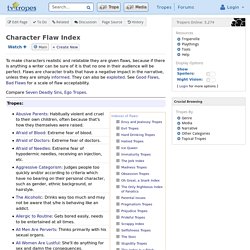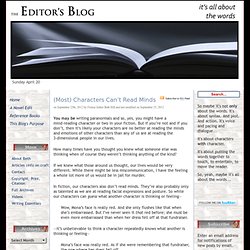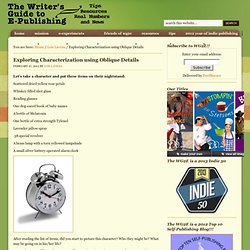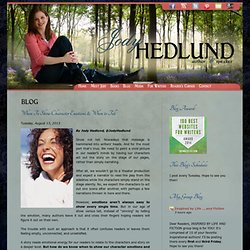

200 Word Descriptive Hair List. Words to Describe Skin Color. Character Flaw Index. To make characters realistic and relatable they are given flaws, because if there is anything a writer can be sure of it is that no one in their audience will be perfect.

Flaws are character traits that have a negative impact in the narrative, unless they are simply informed. They can also be exploited. See Good Flaws, Bad Flaws for a scale of flaw acceptability. Compare Seven Deadly Sins, Ego Tropes. Abusive Parents: Habitually violent and cruel to their own children, often because that's how they themselves were raised. Heroes and Villains. Heroes and villains–they’re of course at opposite end of the spectrum, in terms of characters, but they share more than might be obvious at first glance, and if you’re in the business of writing fiction and creating such characters, it can be useful to think about those things.

Of course, the principal element that heroes and villains have in common is their function in terms of the story: it is their interaction which determines the main action of the plot. At its most basic, it is either that the hero is being specifically targeted by the villain, or the villain has general nefarious plots which the hero sets out to foil. But a common function in the plot isn’t the only thing these two extreme types of characters share. They are leaders, not followers, and they also share high doses of intelligence, imagination and determination, all of which are neutral qualities to be used for either good or bad. Warts and All. The title of this post comes from a (probably apocryphal) story about Oliver Cromwell asking to have his portrait painted without any of the flattering techniques of portraits of the time–he wanted to be shown as he really looked, ‘warts and all’.

I’ve been thinking a lot, lately, about what this phrase means to us as writers–about how we go about constructing characters who seem truly human, not representations of some impossible ideal. Now, we all know that we can’t make our heroes and heroines too perfect. No one wants to read about a character who is unfailingly wise, kind, thoughtful, considerate, and whose hobbies include reading to the blind, feeding the homeless, and caring for small fluffy bunnies. We all want heroes and heroines with real, human flaws. And yet it’s a delicate balance, I think. It’s a balance that I’ve been wrestling with in my own WIP, because my heroine is definitely flawed. How to Restore a Character’s Voice When They Develop Laryngitis. You’re writing a novel and it’s going well.

Your characters are solid, enfleshed, more real to you than yourself on many days. And this is great, because writing is easier when you’re like that celery stalk in third grade – the one stuck in a beaker of blue ink for lessons in osmosis. Story runs through your veins, into all extremities. If sliced open, what seeps from you would contain characters, setting, and theme. Then Life happens. This was me some time ago. Take Your Characters to Therapy. “Every character should want something–even if it is only a glass of water.”

–Kurt Vonnegut Vonnegut was right, of course. How to Write a Character From Start to Finish. Master Class #1. How to Raise Your Characters Above the Status Quo. How to Avoid Parenting Your Characters. Characters Don't Know What Other Characters Think. On September 25th, 2012 by Fiction Editor Beth Hill and last modified on September 25, 2012 You may be writing paranormals and so, yes, you might have a mind-reading character or two in your fiction.

But if you’re not and if you don’t, then it’s likely your characters are no better at reading the minds and emotions of other characters than any of us are at reading the 3-dimensional people in our lives. How many times have you thought you knew what someone else was thinking when of course they weren’t thinking anything of the kind? If we knew what those around us thought, our lives would be very different. While there might be less miscommunication, I have the feeling a whole lot more of us would be in jail for murder. In fiction, our characters also don’t read minds. Wow, Mona’s face is really red. How to Explore Your Characters’ Motivations. Exploring Characterization using Oblique Details. Let’s take a character and put these items on their nightstand: Scattered dried yellow rose petals Whiskey filled shot glass Reading glasses One dog-eared book of baby names.

Writers Facing Fear for Our Characters and for Us as Human Beings (Part One) There are a few things (okay maybe more than a few things) I simply don’t like.

Arrogance and entitlement. Waiting (even having four children I still have the bare minimum of patience.) People who have loads of money but still cry poor mouth. Chaos. Poor hygiene. The Most Important Character Archetype. Questions to Ask (& Strengthen) Your Minor Characters. Supporting characters better our understanding of the main character and the circumstances she finds herself in, whether long-term (I need to solve this homicide case) or short-term (I need a ham sandwich).

And if your supporting characters aren’t working toward an understanding of the main character or situation in some way, you might ask yourself what they’re really doing there, hogging time and space in your book. Your novel isn’t an open house for complete strangers to walk through as they wish. Everything you spend time on must be for a reason, including those minor characters who appear to be simply passing through. That said, your supporting cast can’t seem like they’re only hanging around to provide information or further the plot. For example, let’s start with a simple premise and conflict—a man and woman on an uncomfortable dinner date—and consider what that situation calls for in terms of supporting characters. When To Show Character Emotions & When to Tell. By Jody Hedlund, @JodyHedlund Show not tell.

Nowadays that message is hammered into writers' heads. And for the most part that's true. She's Such a Character: 8 Tips for Creating Characters. By Janice Hardy, @Janice_Hardy I'm well into week two of a terrible cold, but just well enough to get something accomplished, so I'm dipping into the archives again. Here are some tips to consider when creating a character. Characters make the story. No matter how intriguing the idea or exciting the plot, if there isn't a character there we care about (even if it's just curiosity or fascination) the rest of it falls flat. How to Write a Character From Start to Finish. The best fiction is about a character who changes in some significant way. The selfish brute learns to put others first. The woman marrying for money decides to marry for love.
The career ladder climber learns to cut back on his hours to enjoy his family. The bitter old crone learns to let others in. Character Checklist. How Do You Build A Strong Character In Your Writing? How To Write Great Characters. Great characters don’t just happen, they are more than just written-they are born. Scarlet O’Hara, The Wicked Witch of the West, Beetlejuice, Mary Poppins, and Tony Montana all had obvious needs, wants, fears and idiosyncrasies that made them unique and recognizable.
And although they live purely on paper and film, their characterization is built with such realism it is as if they could be the nanny next door, the spoiled brat in the big house down the street or the Mafioso in the neighboring town. That is the magic that happens with writing the perfect character. Developing interesting, colorful characters is not an easy task.
By remembering six core issues when writing can help bring your characters off the page and into the coffee shop at the end of the block. Name That Character: Top Ten Tips. There are a plethora of movie character names that become everlasting brands in American culture: Rocky, Yoda, Forrest Gump, and Shrek to name a few. And when it comes to naming characters, you want to choose wisely, which is no easy task. Literature: Lennie Small: the mentally disabled but physically strong protagonist in John Steinbeck’s 1937 novella Of Mice and Men. Drama: Willy Loman: the elderly salesman lost in false hopes and illusions in Arthur Miller’s 1949 play Death of a Salesman. Film: “The Dude”: the unemployed L.A. slacker and avid bowler in Joel and Ethan Coen’s 1998 film The Big Lebowski. Writing builds character. Hi, peeps! How Morals and Basic Needs Influence a Character’s Positive Traits. By Becca Puglisi, @BeccaPuglisi.
Web Resources for Developing Characters. When developing characters, many writers use personality traits that they see in themselves and in others, such as friends, family and celebrities. Handling a Cast of Thousands - Part I: Getting to Know Your Characters. By Will Greenway. How to Create Fictional Characters - PoeWar. 25 Things You Should Know About Character - StumbleUpon.
3 Steps to Writing a Novel with Unforgettable Characters. Self-Published Authors Helping Other Authors. The antagonist or antagonists of a story are often the central driving force to the story or what causes the central driving force to come into being. That being said, a lot of thought has to go into creating an antagonist, especially the central antagonist. In fact, for horror novelists such as myself, it’s often one of the first things we come up with in a story, and what we often use to describe our stories to others (ex. Amanda Patterson (123 Ideas for Character Flaws) 7 Essential Elements of Character Creation. Definition of Third Person Omniscient. Definition: Third person omniscient is a method of storytelling in which the narrator knows the thoughts and feelings of all of the characters in the story, as opposed to third person limited, which adheres closely to one character's perspective.
Things to Avoid When Writing Interracial Romance - African American Lit. How to Undress a Victorian Lady in Your Next Historical Romance. How to Develop a Character for a Story: 5 steps. How to Create a Character Profile. Welcome to Fuck Yeah Character Development. What dialect do you speak? A map of American English. Amanda Patterson (123 Ideas for Character Flaws) Creating Memorable Characters. Character Questionnaire. 7 Essential Elements of Character Creation. The 100 Most Important Things To Know About Your Character (revised)
Www.caryss.net/junk/char_ques.pdf. CALLIHOO Writing Helps. Wp-content/uploads/2013/10/character-profile-questionnaire.pdf. Wp-content/uploads/2013/10/Reverse-Backstory-Tool.pdf. Wp-content/uploads/2013/10/Target-Tool.pdf. Wp-content/uploads/2013/10/Character-Pyramid.pdf. Getting To Know Your Characters: 1000 Character Development Questions. The 100 Most Important Things To Know About Your Character (revised) Www.errantdreams.com/files/365charques.pdf. CHARACTER QUESTIONNAIRE. Ywp.nanowrimo.org/files/ywp/ywp_10_hs_developed_characters.pdf.
Character Chart. Character Questionnaires - Get to Know Your Characters. 100 Character Development Questions for Writers. Attaching the Flesh: A Character Questionnaire. Character Chart for Fiction Writers - EpiGuide.com. Building Fictional Characters. 8 Ways to Write Better Characters. The Character Therapist. Attaching the Flesh: A Character Questionnaire. 100 Character Development Questions for Writers.